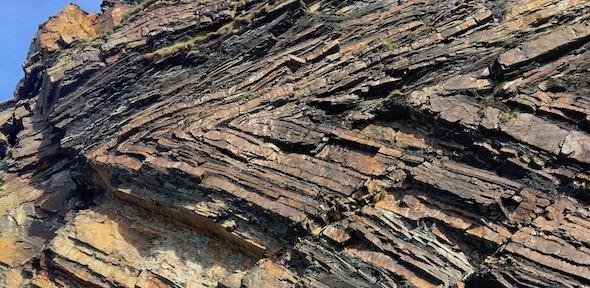- 1 The IB Earth Sciences A course examines the creation of the sedimentary record, without which we would have little idea about the past history of the Earth. As such, this course concentrates on the surface environments of the Earth—the atmosphere, hydrosphere and biosphere—together with their geological products.
- 2 Introduction
- 3 Maps and Structures
- 4 Tectonics and Geodynamics
- 5 Sedimentary Basins
- 6 Climate, Ocean Circulation and Chemistry
- 7 Sedimentology
- 8 Evolutionary Palaeobiology, Micropalaeontology & Vertebrate Palaeontology

The IB Earth Sciences A course examines the creation of the sedimentary record, without which we would have little idea about the past history of the Earth. As such, this course concentrates on the surface environments of the Earth—the atmosphere, hydrosphere and biosphere—together with their geological products.
Introduction
The course largely follows a source-to-sink perspective. We begin with sections on structural geology and tectonics with a focus on the uplift of highlands and formation of basins, which provide accommodation space for deposition of the sedimentary record. We examine how sedimentary particles of lithic and biogenic compositions are produced, deposited in the ocean, and eventually lithified to become the rock record. Along the way, we learn about the physical circulation of the ocean and dissolved chemistry of seawater, as well as its link to biological processes. We end the year looking at the invertebrate and vertebrate life which is contained within this record and which provides a tool reconstruct large-scale climate and biological evolution.
The IB Earth Sciences A course draws upon concepts from the physics, chemistry, and biological coursework you may have taken, however only knowledge of Part IA Earth Sciences is assumed. In exceptional cases it may be possible to read Part IB Earth Sciences without having read Earth Sciences at Part IA, but this needs careful discussion with the course coordinator and your college Director of Studies.
Students should be aware that course choices in Part IB could affect options in Parts II & III.
Full details of the course are available in the .
The sections below give an overview of each module taught within the IA ESA course.
Maps and Structures
The focus of this part of the course is developing an in-depth understanding of deformation structures - folds, faults and fractures - on scales from microscope slide specimens to mountain ranges. The mapping skills taught will be essential for the Part II mapping project, the practical components of the course also provide an overview of structures in South West England, many of which are to be seen on the Easter field trip.
Tectonics and Geodynamics
This course outlines the geophysical tools used to investigate how the Earth is deforming, providing an introduction to geophysics Part II and III. Plate tectonics is discussed further, particularly in regard to earthquakes. Lectures and practicals on seismic reflection profiling also allow a look at deep crustal structure, particularly of continental rifts and margins. Practicals apply these concepts to real data: diagnosing, detecting, and working with seismological observations.
Sedimentary Basins
This course shows how the three main components of stratigraphic geology—tectonics, sedimentology and palaeontology—contribute to our understanding of the way in which the Earth’s lithosphere deforms to generate sedimentary basins. We discuss the formation, filling and death of sedimentary basins, and by using a variety of tools, the principal types of sedimentary basin are described and analysed. Emphasis is on using simple calculations to extract information about vertical motions of the Earth’s surface. This course leads into Part II and III options in Geophysics and Basin Modelling, still the most commercially productive of the many applications of our geological expertise.
Climate, Ocean Circulation and Chemistry
These lectures link the Earth Sciences A course to our understanding of climate dynamics, and introduce ideas from both physical and chemical oceanography. With ocean circulation a recurring theme, the lectures and practicals investigate the salinity of the oceans, biological and physical processes that cause chemical changes during long- and short-term climate change, and also produce the marine sedimentary record. By the end of the course you should understand the Earth as a complex, evolving system of interactions between the atmosphere, the oceans, the biosphere and the geosphere. This course leads on to many options in oceanography and climate science in Part II and III.
Sedimentology
This course studies the entire range of present and past surface environments on the Earth, and the hallmarks they leave on the sedimentary rocks that are deposited in them. By the end of the course you should have a full understanding of surface processes that cause sedimentary deposition, and be able to reconstruct palaeoenvironments by analysing the rock record, an essential tool for a geologist.
Evolutionary Palaeobiology, Micropalaeontology & Vertebrate Palaeontology
This lecture course exposes principles of evolutionary biology, using examples from palaeontology to illustrate particular concepts such as morphospace, and ideas from ecology. In the Micropalaeontology section, the full range of important planktonic and benthic microorganisms are studied; their ecology, evolutionary history and impact on global change is discussed. Vertebrate palaeontology comprises the last lecture course, focussing on the history of dinosaurs, birds, and early tetrapods, and leads on to the Part II and III courses in evolutionary biology and vertebrate palaeontology.
